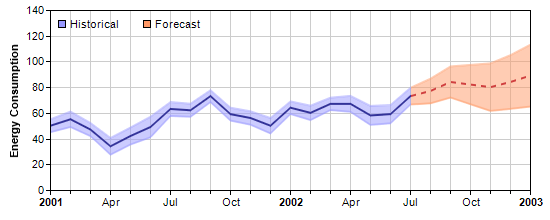
This example demonstrates using x zone colors - colors that change at certain x value thresholds.
In this example, a x zone colors are used as the color of the line, and as the fill color of the band surrounding the line.
The x zone color for the line is configured to change from solid blue color to a red dash line color upon reaching a certain x value threshold. The x zone color for the band is configured to change from semi-transparent blue to semi-transparent red upon reaching the same threshold.
X zone colors are created using
Layer.xZoneColor. You can use a x zone color in any ChartDirector API that expects a color. For instance, you can use a x zone color as background color, fill color of data sets, line color, etc.
A single x zone color can support one threshold value and change between two colors. The two colors can be any colors, including another x zone color. You may create x zone colors with multiple thresholds by cascading multiple x zone colors this way.
The following is the command line version of the code in "cppdemo/xzonecolor". The MFC version of the code is in "mfcdemo/mfcdemo". The Qt Widgets version of the code is in "qtdemo/qtdemo". The QML/Qt Quick version of the code is in "qmldemo/qmldemo".
#include "chartdir.h"
int main(int argc, char *argv[])
{
// The data for the chart
double data[] = {50, 55, 47, 34, 42, 49, 63, 62, 73, 59, 56, 50, 64, 60, 67, 67, 58, 59, 73, 77,
84, 82, 80, 84, 89};
const int data_size = (int)(sizeof(data)/sizeof(*data));
// The error data representing the error band around the data points
double errData[] = {5, 6, 5.1, 6.5, 6.6, 8, 5.4, 5.1, 4.6, 5.0, 5.2, 6.0, 4.9, 5.6, 4.8, 6.2,
7.4, 7.1, 6.5, 9.6, 12.1, 15.3, 18.5, 20.9, 24.1};
const int errData_size = (int)(sizeof(errData)/sizeof(*errData));
// The timestamps for the data
double labels[] = {Chart::chartTime(2001, 1, 1), Chart::chartTime(2001, 2, 1), Chart::chartTime(
2001, 3, 1), Chart::chartTime(2001, 4, 1), Chart::chartTime(2001, 5, 1), Chart::chartTime(
2001, 6, 1), Chart::chartTime(2001, 7, 1), Chart::chartTime(2001, 8, 1), Chart::chartTime(
2001, 9, 1), Chart::chartTime(2001, 10, 1), Chart::chartTime(2001, 11, 1), Chart::chartTime(
2001, 12, 1), Chart::chartTime(2002, 1, 1), Chart::chartTime(2002, 2, 1), Chart::chartTime(
2002, 3, 1), Chart::chartTime(2002, 4, 1), Chart::chartTime(2002, 5, 1), Chart::chartTime(
2002, 6, 1), Chart::chartTime(2002, 7, 1), Chart::chartTime(2002, 8, 1), Chart::chartTime(
2002, 9, 1), Chart::chartTime(2002, 10, 1), Chart::chartTime(2002, 11, 1), Chart::chartTime(
2002, 12, 1), Chart::chartTime(2003, 1, 1)};
const int labels_size = (int)(sizeof(labels)/sizeof(*labels));
// Create a XYChart object of size 550 x 220 pixels
XYChart* c = new XYChart(550, 220);
// Set the plot area at (50, 10) and of size 480 x 180 pixels. Enabled both vertical and
// horizontal grids by setting their colors to light grey (cccccc)
c->setPlotArea(50, 10, 480, 180)->setGridColor(0xcccccc, 0xcccccc);
// Add a legend box (50, 10) (top of plot area) using horizontal layout. Use 8pt Arial font.
// Disable bounding box (set border to transparent).
LegendBox* legendBox = c->addLegend(50, 10, false, "", 8);
legendBox->setBackground(Chart::Transparent);
// Add keys to the legend box to explain the color zones
legendBox->addKey("Historical", 0x9999ff);
legendBox->addKey("Forecast", 0xff9966);
// Add a title to the y axis.
c->yAxis()->setTitle("Energy Consumption");
// Set the labels on the x axis
c->xAxis()->setLabels(DoubleArray(labels, labels_size));
// Set multi-style axis label formatting. Use Arial Bold font for yearly labels and display them
// as "yyyy". Use default font for monthly labels and display them as "mmm". Replace some labels
// with minor ticks to ensure the labels are at least 3 units apart.
c->xAxis()->setMultiFormat(Chart::StartOfYearFilter(), "<*font=Arial Bold*>{value|yyyy}",
Chart::StartOfMonthFilter(), "{value|mmm}", 3);
// Add a line layer to the chart
LineLayer* layer = c->addLineLayer();
// Create the color to draw the data line. The line is blue (0x333399) to the left of x = 18,
// and become a red (0xd04040) dash line to the right of x = 18.
int lineColor = layer->xZoneColor(18, 0x333399, c->dashLineColor(0xd04040, Chart::DashLine));
// Add the data line
layer->addDataSet(DoubleArray(data, data_size), lineColor);
// Create the color to draw the err zone. The color is semi-transparent blue (0x809999ff) to the
// left of x = 18, and become semi-transparent red (0x80ff9966) to the right of x = 18.
int errColor = layer->xZoneColor(18, 0x809999ff, 0x80ff9966);
// Add the upper border of the err zone
layer->addDataSet(ArrayMath(DoubleArray(data, data_size)).add(DoubleArray(errData, errData_size)
), errColor);
// Add the lower border of the err zone
layer->addDataSet(ArrayMath(DoubleArray(data, data_size)).sub(DoubleArray(errData, errData_size)
), errColor);
// Set the default line width to 2 pixels
layer->setLineWidth(2);
// Color the region between the err zone lines
c->addInterLineLayer(layer->getLine(1), layer->getLine(2), errColor);
// Output the chart
c->makeChart("xzonecolor.png");
//free up resources
delete c;
return 0;
}
© 2023 Advanced Software Engineering Limited. All rights reserved.
